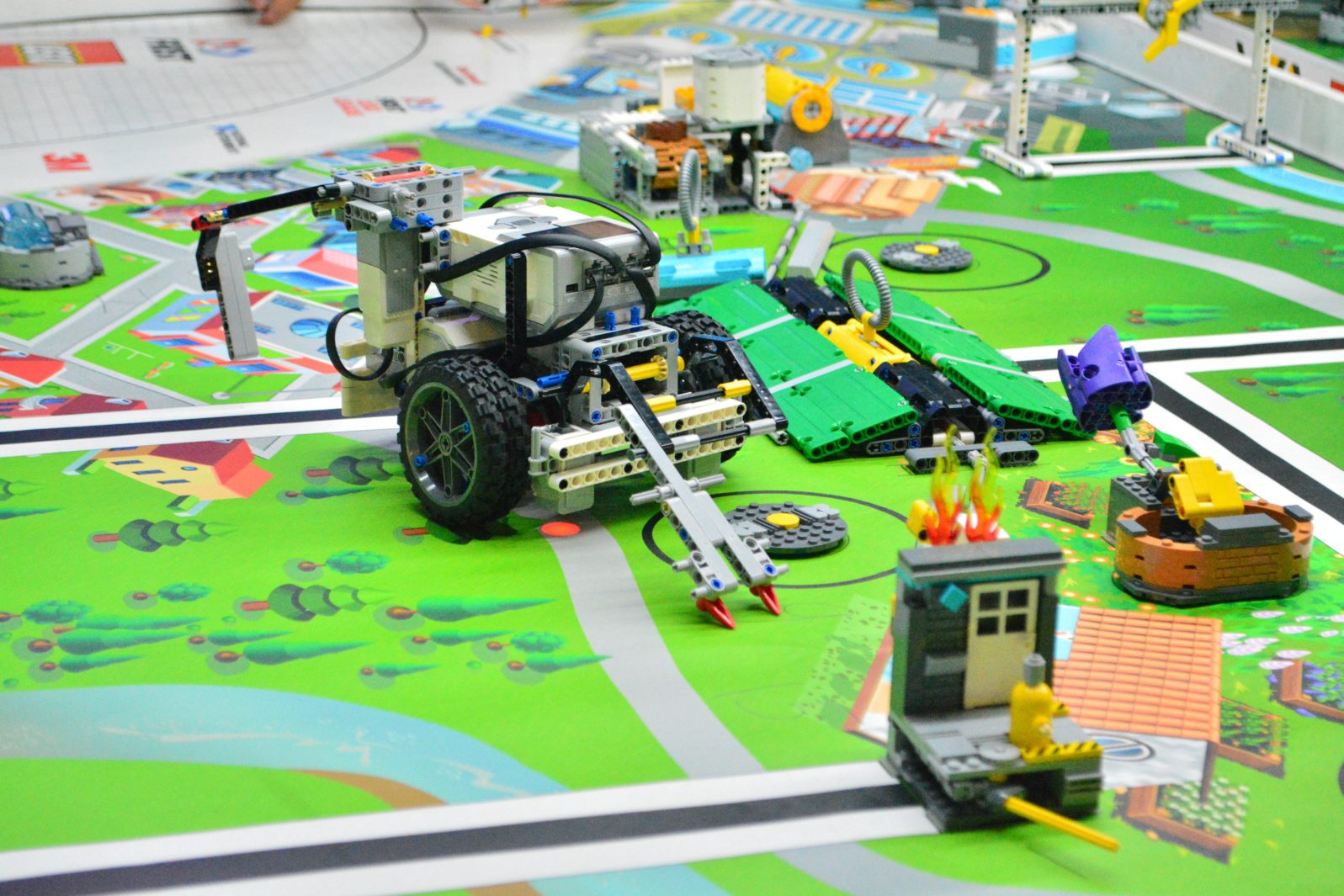A Lego Toy That Solves Mazes May Bring New Hope to Amputees
Organic materials that enable computer chips to work like neurons could improve the usability of prosthesesA Lego toy robot with an organic brain, programmed to solve mazes, promises better prostheses:
In the winter of 1997 Carver Mead lectured on an unusual topic for a computer scientist: the nervous systems of animals, such as the humble fly. Mead, a researcher at the California Institute of Technology, described his earlier idea for an electronic problem-solving system inspired by nerve cells, a technique he had dubbed “neuromorphic” computing. A quarter-century later, researchers have designed a carbon-based neuromorphic computing device—essentially an organic robot brain—that can learn to navigate a maze.
Saugat Bolakhe, “Lego Robot with an Organic ‘Brain’ Learns to Navigate a Maze” at Scientific American (January 28, 2022)
The difference between a regular materials-only computer chip made of silicon and a neuromorphic chip made of organic materials is that the neuromorphic chip rewires its own electric circuits so as to save a new function, in the way that a brain rewires itself to save a memory. That’s one reason our limbs work as well as they do.
The current research, headed by Paschalis Gkoupidenis of the Max Planck Institute for Polymer Research in Mainz, Germany, used long strings of carbon-based molecules (polymers) that show some similarities to living tissues:
This polymer (known as p(g2T-TT)) is not only stable, but it also is able to ‘retain’ a large part of the specific states in which it has been tuned during the various runs through the labyrinth. This ensures that the learned behaviour ‘sticks’, just like neurons and synapses in a human brain remember events or actions…
In their research (dating from 2015 and 2017), they proved that the material can be tuned in a much larger range of conduction than inorganic materials, and that it is able to ‘remember’ or store learned states for extended periods. Since then, organic devices have become a hot topic in the field of hardware-based artificial neural networks.
Eindhoven University of Technology, “‘Human-like’ brain helps robot out of a maze” at ScienceDaily (December 10, 2021) The paper is open access.
The researchers coated the polymer with an iron-rich gel to help it act more like a biological material like a neuron, which carries an electric charge in a liquid environment.
And the prostheses? There have been promising improvements in prostheses in recent years but prosthetists still face the problem of the silicon interface with biological materials. Organic materials should work better:
Polymeric materials also have the added advantage that they can be used in numerous biomedical applications. “Because of their organic nature, these smart devices can in principle be integrated with actual nerve cells. Say you lost your arm during an injury. Then you could potentially use these devices to link your body to a bionic hand,” says Krauhausen.
Eindhoven University of Technology, “‘Human-like’ brain helps robot out of a maze” at ScienceDaily (December 10, 2021) The paper is open access.

Now, about the robot:
The robot that Krauhausen and her colleagues used for their research is a Mindstorms EV3, a robotics kit made by Lego. Equipped with two wheels, traditional guiding software to make sure it can follow a line, and a number of reflectance and touch sensors, it was sent into a 2 m2 large maze made up out of black-lined hexagons in a honeycomb-like pattern.
The robot is programmed to turn right by default. Each time it reaches a dead end or diverges from the designated path to the exit (which is indicated by visual cues), it is told to either return or turn left. This corrective stimulus is then remembered in the neuromorphic device for the next effort.
“In the end, it took our robot 16 runs to find the exit successfully,” says Krauhausen. “And, what’s more, once it has learned to navigate this specific route (target path 1), it can navigate any other path that it is given in one go (target path 2). So, the knowledge it has acquired is generalizable.”
Eindhoven University of Technology, “‘Human-like’ brain helps robot out of a maze” at ScienceDaily (December 10, 2021) The paper is open access.
Generalizable knowledge is very important for a prosthesis. The big problem with silicon chip interfaces is that they do not typically learn things that can be generalized, the way our natural hands and feet generalize them. The wearer may be faced with constantly reprogramming an electronic prosthesis, which takes a lot of time and dedication for a little bit of function.
Carver Mead, Professor Emeritus of Engineering and Applied, California Institute of Technology, spoke at COSM 2021 (November 11), offering some thoughts on the overall direction of neuromorphic chips:
Mead: The thing about information is, it can take on many forms. But it doesn’t exist unless it’s in a physical form. Some physical forms can be translated from one physical form to another, but until the last steps embodied in a physical form, it doesn’t exist. So computer scientists get lost in the mathematics of the abstract stuff and don’t think about the physical form that brings it to life.
 Rob Crowther said to use this one.
Rob Crowther said to use this one.That’s the electronic prosthesis wearer’s problem, exactly. Until the prosthesis can be got to respond consistently to commands from the brain and make adjustments easily, no matter how sophisticated, it is still just tiresome hardware.
Mead: So if you look at training a neural network, what do you do? The basic operations are, you have an input and you have somehow an answer that this input should generate. So you look the answer you got from the network, and if it’s different from the answer, that’s correct. Then you correct the network. If you have a database where you have all the known right answers, that’s an incredibly small fraction of data.
So there’s a better way to go about things if you want a lot of data. And that was mentioned today, the self-training network. I described an architecture for that in my 1990 paper. And it goes like this. You think of the network as a model. You put in inputs and what the model does is predict what the next input will be. It turns out many, many problems have very large set of problems can be put in that form.
Indeed. That’s how our natural hands work. They know that if you enter a dark room, they should start fumbling for the light switch. You don’t need to tell them to do that; they are not sorting through a large number of options.
Mead: Then the model, the neural network, puts out an output, which is a prediction of what the next input will be. Well, then you compare the next input with the prediction and if they’re the same, you don’t do anything. If they’re different, you’re correct the network by a backpropagation algorithm and you put out an output to the next level.
So you’ve done a wonderful thing. You’ve not only trained the network to be a better model for the stream of data coming through, but you’ve purified it so that the output of the model only tells you when something’s interesting to the next level. Because if you’ve predicted it already, you have that information captured in that level of a network… This is what a lot of the brain does.
Likewise, our brains and sensory systems “hide” masses of information from us, directing our attention only to what is new (for example, it’s the same street corner but a city works crew is jack hammering the pavement).
There will be many other uses for neuromorphic computing, as the discipline advances from Carver Mead’s brainstorm a quarter century ago.
Note: The feature photo of a Mindstorm competition is by Hung Nguyen Phi on Unsplash
You may also wish to read: The Bionic Man was science fiction; the bionic hand is not. A recent internet-savvy bionic hand, developed by an American neuroscientist and computer engineer, is the most flexible yet, with sensory feedback. The trouble is, if the new bionic hands are going to help most of the world’s amputees , they can’t cost six million dollars, as in the old TV show.
Prosthetic hand controlled by thoughts alone? It’s here. Decades ago, no one could control a prosthesis only by thought. There is lots of room for the field to grow still. (2020)
New mind-controlled robot arm needs no brain implant. The thought-controlled device could help people with movement disorders control devices without the costs and risks of surgery. (2019)
High tech can help the blind see and amputees feel. It’s not a miracle; the human nervous system can work with electronic information. (2019)

